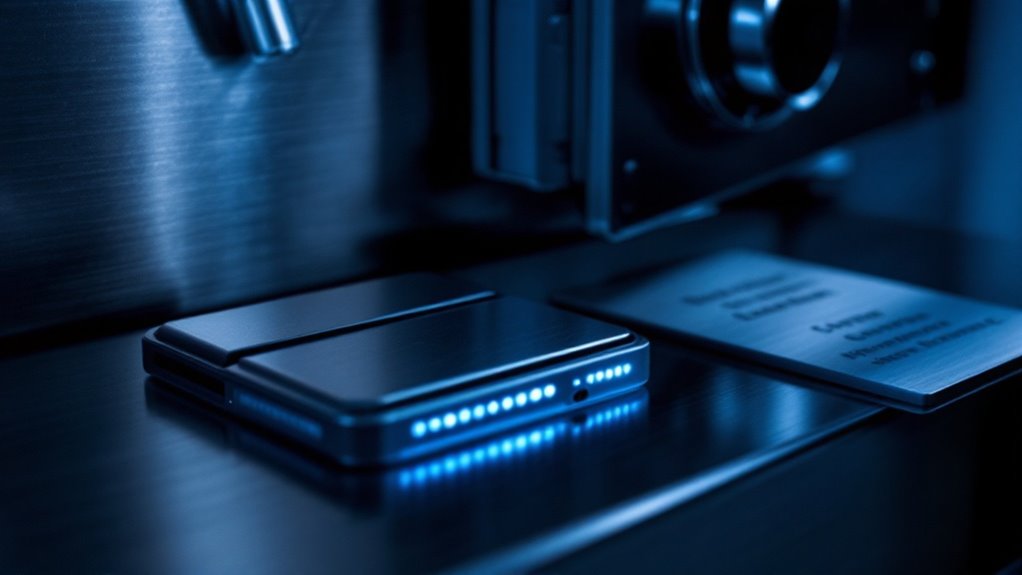Hardware wallets represent an essential leap forward in cryptocurrency security, combining robust encryption with tamper-resistant hardware. These compact devices, no larger than USB drives, keep private keys safely offline while enabling secure transactions through their built-in screens. Users maintain direct control over their digital assets without relying on exchanges, though the process requires careful attention to security protocols. Like a digital fortress, hardware wallets transform virtual wealth into tangible protection, though mastering their full potential requires understanding their intricate features.

As cryptocurrency adoption continues to surge, hardware wallets have emerged as digital armor for investors seeking iron-clad protection of their assets. These physical devices, often no larger than a USB thumb drive, pack sophisticated security features that transform abstract digital wealth into tangible, fortress-like protection. Private key management ensures users maintain complete control over their digital assets without relying on exchanges.
Like a bank vault you can slip into your pocket, hardware wallets combine robust encryption with tamper-resistant hardware to keep private keys safely offline and away from prying eyes. The ability to conduct cold storage transactions makes them ideal for securing large amounts of cryptocurrency. Biometric authentication enhances the security by requiring fingerprint or facial recognition for access.
At the heart of these devices lies a secure element – a specialized chip that generates and stores private keys in complete isolation from the internet's dangers. When users need to make transactions, the device springs to life, displaying critical details on its tiny screen while keeping sensitive data locked away in its digital vault.
It's like having a personal security guard who never sleeps, meticulously verifying every transaction detail before giving approval.
Yet even the strongest armor has its weak points. Users must maneuver around potential vulnerabilities, from supply chain attacks to the ever-present risk of human error. A recovery seed phrase, while essential for backup, becomes a double-edged sword – lose those words, and your digital fortune could vanish into the ether.
Smart investors purchase their devices directly from manufacturers, treating them with the same caution as they would their most precious jewels.
The trade-off between security and convenience is ever-present in the world of hardware wallets. Their deliberate disconnection from the internet makes frequent transactions feel like maneuvering through a maze, and their compact screens can turn transaction verification into a squinting exercise.
However, for those who value peace of mind over split-second access, these minor inconveniences fade against the backdrop of robust protection.
Advanced features like multi-signature support and encrypted backups continue to evolve, pushing the boundaries of what's possible in cryptocurrency security.
While hardware wallets may not be perfect, they represent humanity's best attempt at bridging the gap between the wild west of digital assets and the fort knox-level security that serious investors demand.
Frequently Asked Questions
Can I Recover My Crypto if My Hardware Wallet Manufacturer Goes Bankrupt?
Cryptocurrency can be recovered regardless of manufacturer bankruptcy since recovery seeds follow standardized BIP39 protocol. Users can restore their funds using the seed phrase on any compatible hardware or software wallet supporting this standard.
Are Hardware Wallets Vulnerable to Electromagnetic Pulse (EMP) Attacks?
Hardware wallets are potentially vulnerable to electromagnetic pulse attacks, which can damage their electronic components. However, users can protect against EMP risks using Faraday cages, EMP-resistant containers, and maintaining offline backups of seed phrases.
How Often Should I Update My Hardware Wallet's Firmware?
Hardware wallet firmware should be updated at least every six months, or whenever manufacturers release critical security patches. Users should check regularly for updates and always guarantee they have their recovery seed phrase beforehand.
What Happens if I Accidentally Submerge My Hardware Wallet in Water?
Water exposure can immediately damage electronic components through short-circuiting and corrosion. The device should be powered off, thoroughly dried for 48 hours with desiccant, and not turned on until completely dry.
Can Quantum Computing Break the Encryption of Current Hardware Wallets?
Theoretically, quantum computers could break current hardware wallet encryption using Shor's algorithm to derive private keys from public keys. However, this threat isn't immediate as suitable quantum computers don't yet exist.









